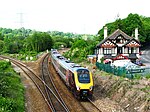Newton St Cyres railway station
1851 establishments in EnglandDfT Category F2 stationsFormer London and South Western Railway stationsPages with no open date in Infobox stationRailway request stops in Great Britain ... and 4 more
Railway stations in DevonRailway stations in Great Britain opened in 1851Railway stations served by Great Western RailwayUse British English from December 2017

Newton St Cyres railway station is a railway station serving the village of Newton St Cyres, Devon, England. It is served by Great Western Railway trains on the Tarka and Dartmoor lines. It is on the Tarka Line to Barnstaple, 4 miles 21 chains (6.9 km) from Exeter Central at milepost 175.75 from London Waterloo.
Excerpt from the Wikipedia article Newton St Cyres railway station (License: CC BY-SA 3.0, Authors, Images).Newton St Cyres railway station
Station Road, Mid Devon
Geographical coordinates (GPS) Address Nearby Places Show on map
Geographical coordinates (GPS)
| Latitude | Longitude |
|---|---|
| N 50.77884 ° | E -3.58915 ° |
Address
Station Road
EX5 5AX Mid Devon
England, United Kingdom
Open on Google Maps











